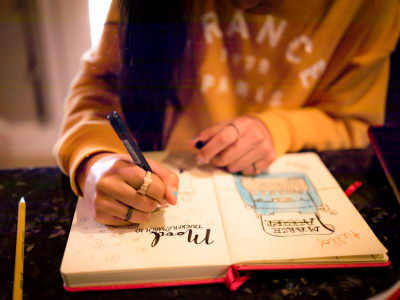
Find Space in Your Home to Journal and Plan
For many people, journals and planners are valuable tools for improving creativity, productivity, or emotional well-being. Whether you want to capture your thoughts, practice your writing skills, express your gratitude, or organize your life, it will be easier to cultivate a daily habit if you dedicate space for these activities.
Even if you’ve been working from a dedicated or improvised home office, it’s best to create a separate place to think, muse, and put pen to paper. A spot for journaling or planning will help you focus on the task at hand and add attractive space to your home.
Do you need a room or a nook? If you don’t have enough rooms to convert one into journaling space, a dedicated nook in another room can work just as well.
Regardless, try to have a beautiful exterior view from your writing space. This will help you rest and refocus your eyes while doing close-up writing by hand.
If you don’t have a window nearby, consider hanging a beautiful work of art at eye level above your writing surface—perhaps using a landscape or seascape as a substitute for a real outdoor view.
What are the essentials for creating a journaling space?
A Desk or Table
It’s essential to have an adequate writing surface. Balancing a book on your lap isn’t always comfortable. A clutter-free space to spread out your book and companion tools will encourage you to do your writing or planning daily.
A Comfortable Chair
A straight back chair may work for a few minutes, but it probably won’t be comfortable over the long haul. Select a chair that encourages good ergonomic posture while also appealing to your sense of aesthetics.
An Appealing Journal or Planner
Choose a book that is equally attractive to the touch and the eyes. Select one that is big enough that it’s easy to write in it, but small enough to carry wherever you go. That way, you will always have your “go-to” book when you need it—to organize, to plan, to capture ideas, to achieve!
An Enjoyable Pen
Writing in your journal or planner should feel delightful. Your pen doesn’t have to be an expensive investment. (Although it can be if you like!)
Avoid any pen that skips or smears ink. You may prefer basic black or blue ink, a fountain pen, a mechanical pencil, or a multi-function pen that offers several colors of ink in one writing instrument. (Tip: Make sure your ink doesn’t bleed through or “ghost” in your planner.)
Good Lighting
Don’t struggle to use your journal because the lighting in your nook is substandard, or your body is casting shadows on your paper. If your writing space is large enough, add a desk lamp. If not, opt for an attractive floor lamp.
Adjustable lighting will help provide enough light to avoid eye strain, even if other lights in the room are turned off.
Create Privacy
Journaling and planning work best in a distraction-free space, so that you can be alone with your thoughts and brainstorm ideas. If you can’t manage a dedicated room, try making your area more private with a room divider or decorative screen.
With or without a physical divider, you may want to invest in noise-canceling headphones, so that you can listen to soft music or nature sounds without the interruption of other activities in the house.
The Extras
Don’t get discouraged by the drool-worthy #plannerspread and #journalspread images you’ll find on Instagram or Pinterest, loaded with artistic drawings and letterings, decorative washi tape and stickers, and more. A journal or planner’s most important attribute is functionality.
Select what works best for you. You may prefer everything in bold black ink. You may want to color-code your journal or create index tabs to stay organized.
When it comes to journaling and planning, you do you.
Your approach will evolve as your needs change. It’s an evolutionary process, but a dedicated space in your home will help you maintain and enjoy the journaling habit.
